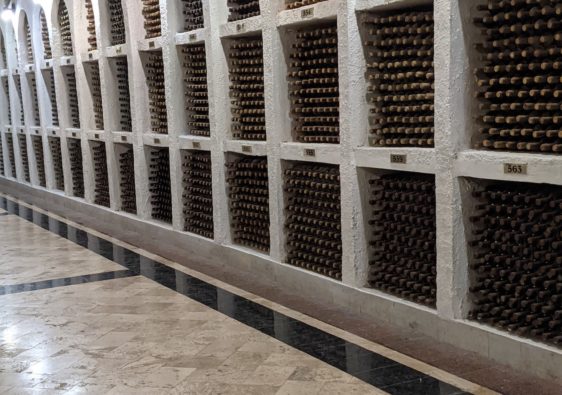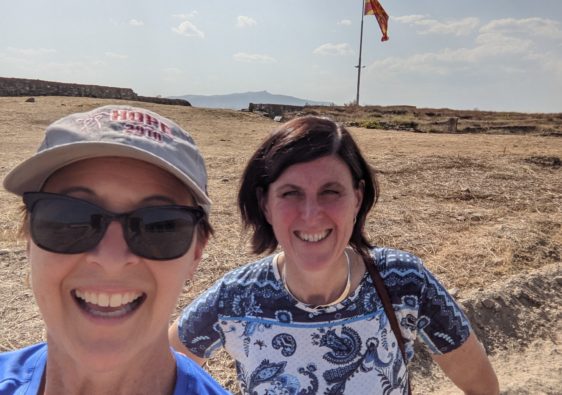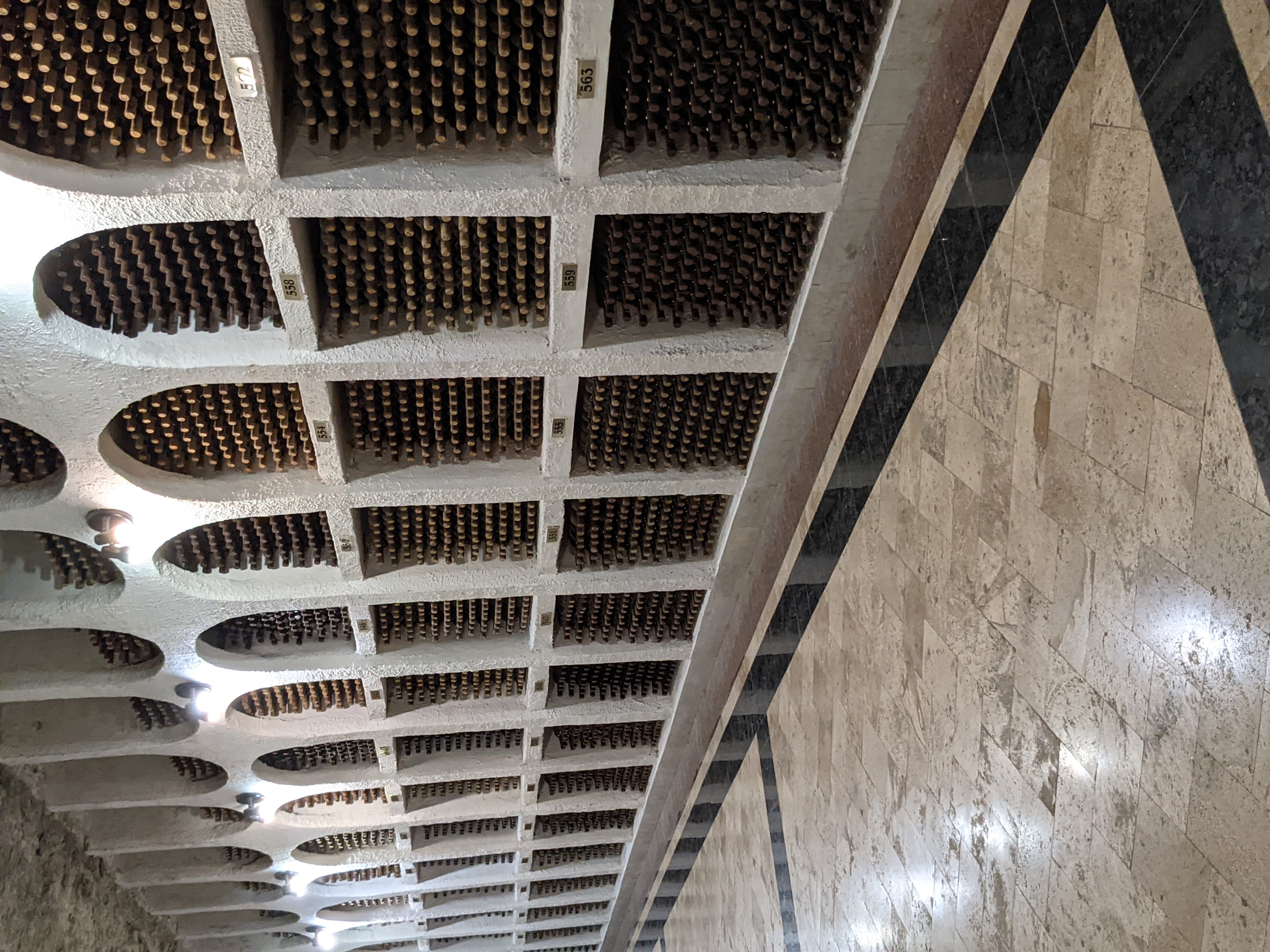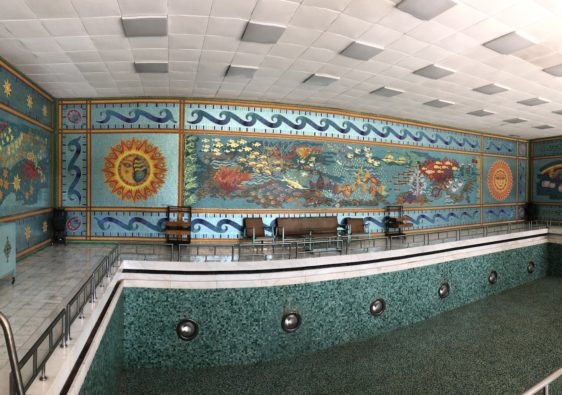We took a MyDayTrips car service from Skopje, North Macedonia to Sofia, Bulgaria. This was the second route we’d done with MyDayTrips so we were feeling more confident with the experience. MyDayTrips provides a car and driver to take you from Point A to Point B, and allows you to select a few tourist destinations along the route [for an added fee per stop]. On this route to Sofia, we selected two monasteries, because the other two options were a waterfall and an ancient fortress, which felt too similar to what we’d done on the Thessaloniki to Skopje route [Matka Canyon and Stobi architectural dig.] We made the right selection, as both monasteries were beautiful, and surpassed our expectations.
- Osogovo Monastery – A Macedonian Orthodox monastery founded in the 12th century in North Macedonia. Perched on a hill overlooking a valley below. Beautiful interior and a ton of steps up and down which was good to get us moving again after sitting in the car for a few hours.



- Rila Monastery – An Eastern Orthodox monastery in Bulgaria, established 927 AD. It is a UNESCO World Heritage site. The chapel sits in a large courtyard, surrounded by rooms where around 60 monks can be housed. [ref: Wikipedia] The site is surrounded by mountains and feels overwhelmingly peaceful.


- Other learnings en route to Sofia on the trip with the MyDayTrips driver:
- As we spoke to our driver, we realized he pronounced Sofia with the emphasis on the first syllable and flattened the name into two syllables SO-fia, versus how we had been pronouncing it with three syllables and the accent on the middle one So-FI-a.
- We heard the counterpoint to our previous day’s discussion with the North Macedonian MyDayTrips driver who told us that Bulgaria should really be East Macedonia. Our Bulgarian driver told us, perhaps unsurprisingly, that Macedonia should be part of Bulgaria, and it had been in years past.
- We also practiced reading Cyrillic lettering, as Bulgaria uses Cyrillic. Michele had studied Russian in college for a year and being a linguist, was still able to read it. I was super excited to read “radio” on the car dashboard in Cyrillic.
- The driver taught us a couple of key words in Bulgarian: Thank you -Благодаря ти (Blagodarya ti), and Cheers- наздраве (nazdrave).
Sofia
Our driver drove us into Sophia, and narrated as he drove. He pointed out the yellow brick roads, signifying the first roads that were paved in the capital, an ambitious plan in the early 1900’s by the then-mayor of the city Martin Todorov. He wanted yellow ceramic bricks to make the central streets look unique. We walked over them later; not sure I would have known what they were otherwise, and not sure I would have noticed them enough to look it up. He also pointed out the Cathedral, Mosque, and Synagogue all grouped in the same block in the heart of Sofia – a fact that he was very proud of; proud of Sophia’s openness and acceptance.


Almost immediately upon leaving our hotel [Hyatt Regency Sofia on points- highly recommend!], we saw the St. Alexander Nevski Cathedral Church – and enjoyed reading signs in Cyrillic. We were aiming for the tree-lined pedestrian-only Vitosha Boulevard which runs through the heart of Sofia. We passed the Saint Nikolas Russian Church, the yellow brick road, and then found the walking district. Sofia felt a little freer, more open – and definitely more “real” compared to Skopje. It felt old and comfortable and lived in, like a university town. The biggest challenge was to pick one of the cafes because there were so many that looked amazing. We found one on a quiet street corner with a folk music vibe.
The next day our goal was to find the markets, and then go to the Museum of Socialist Art. En route to the markets, we found the square our driver had pointed out with the Synagogue, Cathedral, and Mosque. There were a couple of other key sites we wanted to see in downtown Sofia.
- Serdica Archaeological Complex in the heart of the subway system – One of our first stops in the morning was to the ruins that had been found when Sofia was excavating to build the subway. The subway continued to be built, but the ruins were also showcased. There were signs and walkways through the old ruins, and you could spend time walking through them, or you could hurry on your way to the subway. It seemed, to me, an elegant way of balancing both the need for progress and the need to preserve the past. In Thessaloniki there were some half-started subway digs that had not progressed because they kept finding ruins whenever they dug. And with Thessaloniki dotted with ruins, it will a long time before they get a subway system unless they follow Sofia’s model.


- Sofia Synagogue – we had seen numerous Monasteries and cathedrals, so wanted to see the synagogue. It was locked down pretty tight, but we asked to see it, and were allowed to enter after paying an entrance fee. It was beautiful, if perhaps a bit less ornate than the cathedrals we’ve been touring.


- Museum of Socialist Art – A museum dedicated to Soviet propaganda and artwork from that era, including an entire statue garden filled with busts and statues of former communist leaders, from Che Guevara to Stalin and Lenin. We watched a Soviet-era propaganda film, and wandered through an art gallery of Soviet art. Having grown up in the cold war era it still felt sinister.


NOTE: We flew from Sofia to Bucharest as we found quick, direct flights, and we thought we were going to be spending too many days in the car. In retrospect, after reviewing the tourist stop options along the way, and considering how much we enjoyed and learned from our driving days – if I did it again, I’d take a MyDayTrip ride and would have tacked an extra day onto the trip to do it if needed.



